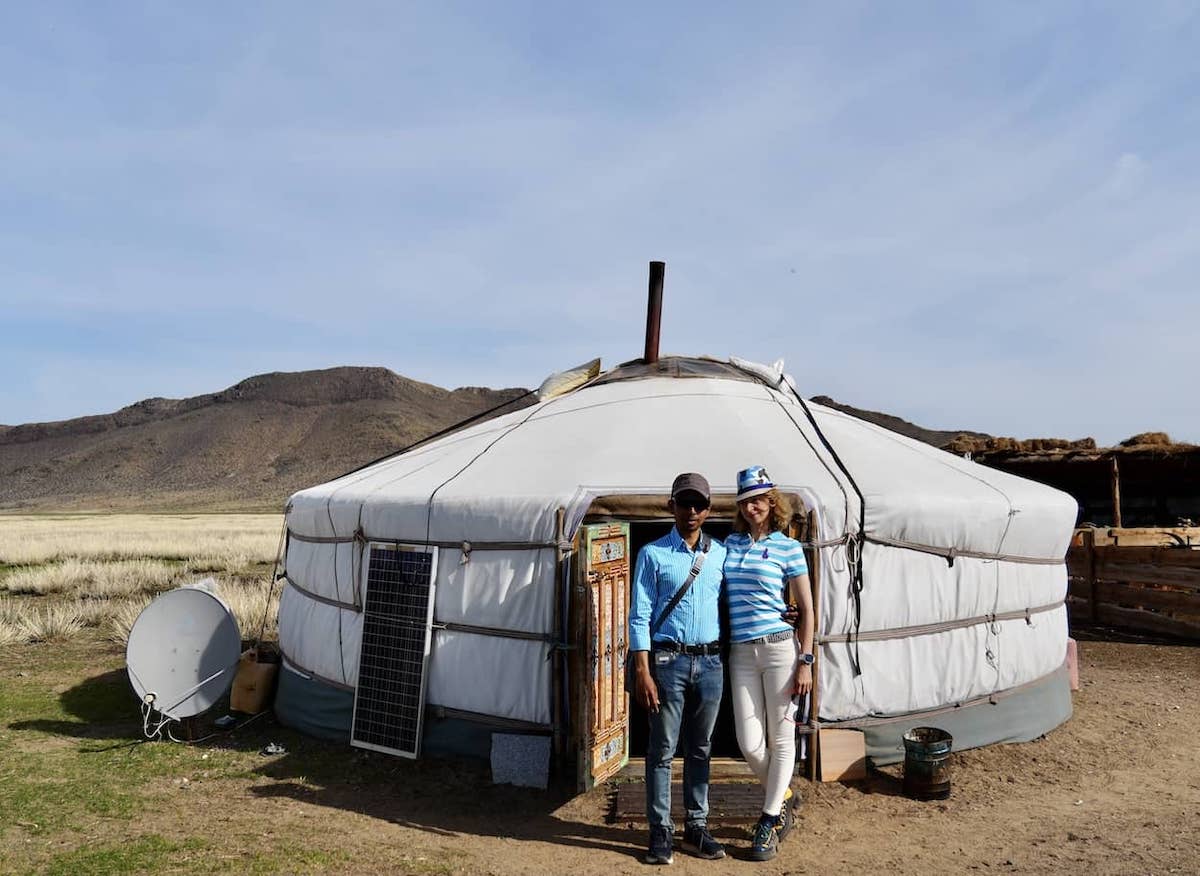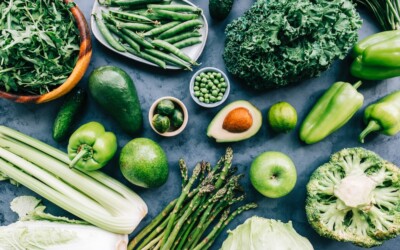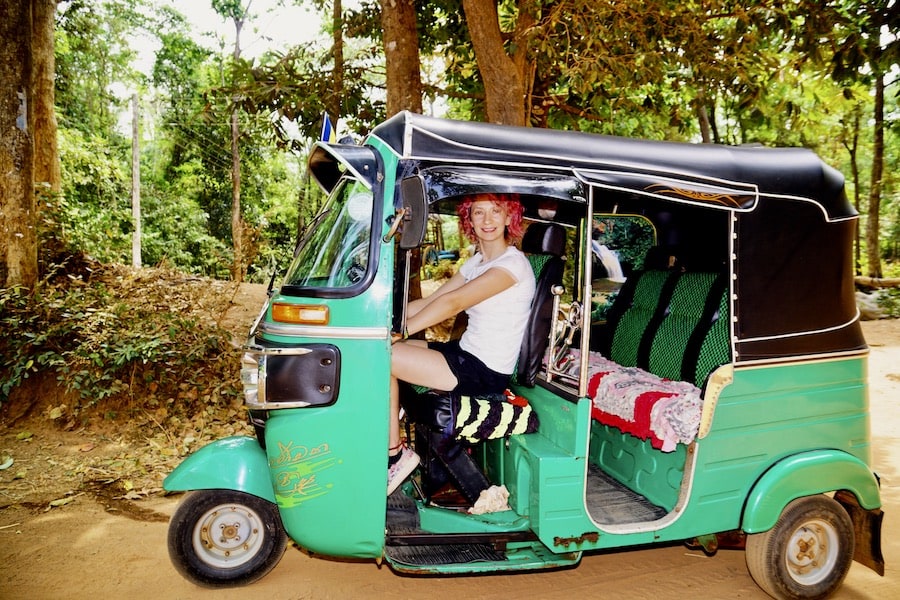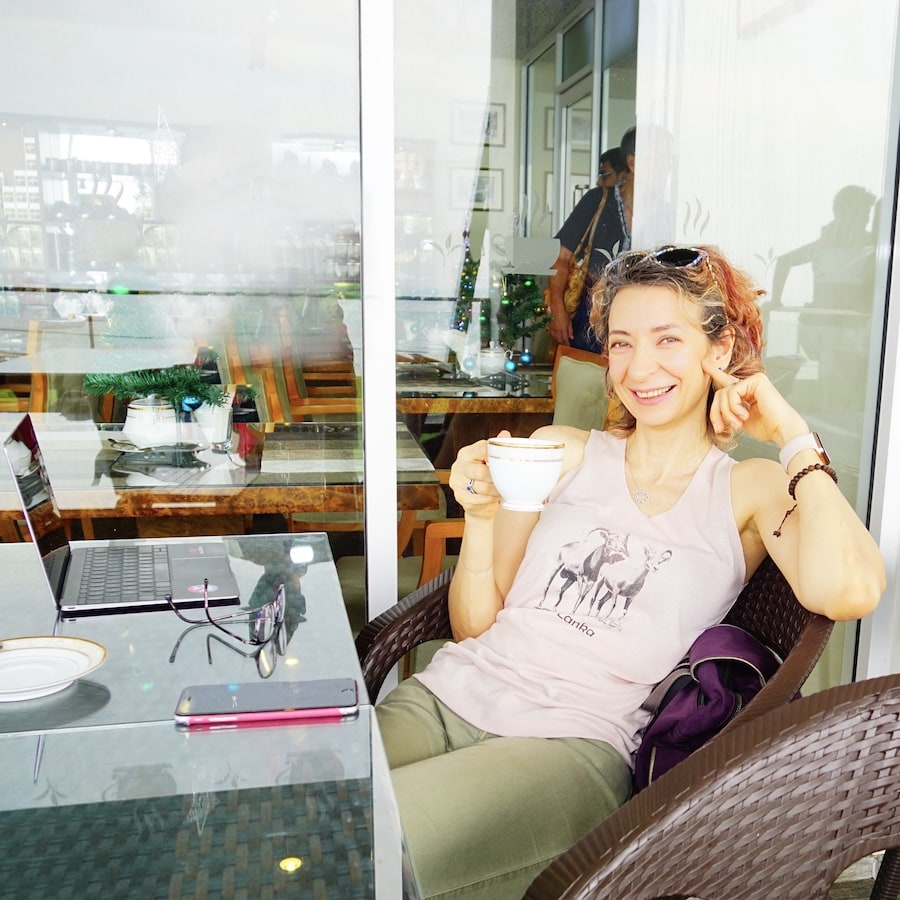Table of Contents
Introduction
Last week, we embarked on what would become one of our most unforgettable adventures—a two-day journey through the expansive and mystical landscapes of Mongolia. Known for its rugged expanses and nomadic culture, Mongolia wasn’t initially at the top of our travel list due to our restricted diet. However, when an opportunity arose, we decided to embrace it without high expectations for food options. We prepared by packing two bags of nuts and purchasing additional mixed nuts from the supermarket, planning to sustain ourselves with these, along with teas, coffee, and water.
The day before our trip, our organiser, Moogii, asked about our dietary preferences. We told her that we don’t consume animal products and weren’t too concerned about food options, as we wanted to focus more on experiencing the country itself rather than the cuisine.
Arrival and First Impressions
We landed in Ulaanbaatar during the early hours, where Moogii, our guide, was waiting to meet us. Despite the late hour, her presence was comforting as she efficiently handled our hotel check-in and informed us she would return at 8 AM to start our journey. The hotel, reminiscent of the ’90s charm, provided a surprisingly comfortable start to our adventure.
We slept like logs and woke up at 6:30 AM, fully refreshed and eager for a new adventure. After our usual morning routine and a cup of tea, we checked out and went exploring. The first shop we visited was a GS25 convenience store.


We popped in and bought some fresh coffee, which was surprisingly good. We noticed many products were from Korea, some from Russia, and very few were local.
The Journey Begins
Moogii’s car was already parked by the hotel when she informed us that her young son, Odee, would be accompanying us on this trip—it was his first trip as well. She explained that Odee is a chef and would be assisting her in preparing vegan meals for us. From there, we started our journey! Moogii mentioned that we would be driving 500 kilometers today, exploring the Western part of Mongolia.


As we drove, we passed through stunning landscapes of valleys and hills. Since it was May, a season when many animals have their offspring, we saw numerous animals grazing on the grass: cows and calves, horses and foals, sheep and lamb, goats and kids were everywhere.




We drove for 30 minutes before making our first stop, where we grabbed some takeaway coffee, then continued our journey.

The views were breathtaking; we saw many gers (traditional Mongolian tents) and animals along the way. We frequently stopped to take pictures of the wildlife.

A Vegan Picnic Amidst the Plains
Approaching lunchtime, Moogii pulled over in the middle of a plains where cows and calves were grazing on the freshly sprouted grass.
Odee and Moogii had planned a picnic for us.

To our delight, they were fully prepared with blankets, groceries, cooking equipment, and cutlery. They laid a blanket on the ground and began setting up a table. They placed teas, coffees, hot water in a thermos, vegan ham, vegan bread, and made a fresh salad for us. While we ate, Moogii and Odee cooked a delicious Mongolian dish on the camping stove—a vegan version, called Tsuivan.


It was the first of many delicious meals that we had in Mongolia.
Gobi Desert and Erdenezuu Monastery
The Gobi Desert is one of the largest deserts in Asia, spreading across southern Mongolia. Known for its wide-open spaces and extreme weather, from very hot to very cold, the Gobi is not just a desert. It’s a place filled with history, where important dinosaur fossils have been found and ancient traders once traveled.
Today, the Gobi is home to unique animals like the Bactrian camel and rare snow leopards. It also features beautiful landscapes, from big sand dunes to valleys covered in ice. A trip to the Gobi Desert offers a chance to see one of the world’s most remote areas and experience its amazing natural beauty.
It was getting very hot when we arrived at the Gobi Desert. Sand was everywhere, and we saw a few domesticated Bactrian camels adorned with colourful blankets, available for tourists to ride.


Riding animals wasn’t something we were interested in as we were more interested in photographing them and the desert itself, which was strikingly beautiful.
I climbed to the top of a sandy hill and watched the stunning expanse of the desert.

Erdenezuu Monastery

Erdenezuu Monastery, nestled near the old capital of Kharkhorin, is a fascinating piece of Mongolia’s religious history. Established in 1585 by Abtai Sain Khan on the ruins of Karakorum, this monastery is considered the oldest surviving Buddhist monastery in Mongolia.
The site was chosen for its historical significance, using stones from Karakorum to build the monastery’s massive walls, which at one time enclosed 108 temples. Through centuries, Erdenezuu has witnessed the ebb and flow of Mongolian history, enduring through periods of religious suppression and resurgence. In the 1930s, it faced severe destruction during religious purges, but it was later restored and transformed into a museum by the 1960s.


Today, visitors to Erdenezuu will find a peaceful complex surrounded by sacred stupas and temples rich with Buddhist art and carvings. The monastery isn’t just a relic of the past; it’s a vibrant part of Mongolia’s cultural and spiritual life, offering a window into the nation’s profound religious traditions.


After driving for a few hours, we arrived at Erdenezuu Monastery.
The monastery was beautifully preserved, transporting us back in time. There were only a few tourists, which added to the magical atmosphere. Odee accompanied us around the monastery while Moogii took a rest.
We wandered from one building to the next, with each room featuring informative labels and explanations in English.


We took our time to capture photos and explore rooms of the monastery at our leisure. The stunning architecture and intricate carvings were primarily decorative, enhancing the historical ambiance.
Additionally, there was a modern section of the monastery where Mongolian locals came to pray, and we observed a few monks in attendance.


After visiting the monastery, it was getting late, so we continued driving. Moogii and Odee took turns at the wheel as we headed to a nomadic family’s home to settle in for the night.
An Unplanned Detour and a Night with a Nomadic Family
We drove for hours along roads that were pleasant yet rugged and unpredictable, filled with potholes as we ventured off the main road through the valley. After what felt like an eternity, and as we passed many gers spaced miles apart, we hoped to reach our destination soon. However, Odee eventually stopped the car when we encountered a shepherd. Moogii immediately started questioning him, and from their conversation, it was apparent that something was amiss. Moogii seemed unhappy and rather annoyed by the situation. My husband and I feared we were lost. It turned out that the nomadic family we were supposed to visit had moved far away and had not communicated.


Exhausted and losing hope of staying in a traditional Ger, we just wanted to find any place where we could rest and have a good night’s sleep to start afresh in the morning. We had to backtrack to the main road and drove for another 40 minutes. All the while, Moogii was on the phone, making several calls until, at last, she found another nomadic family willing to host us. Hurray!
Staying in a Ger with a Nomadic Family
We continued driving, approaching sunset just after 8 PM, and worried we might miss it while still on the road. However, we arrived at the nomadic family’s location just in time. The children were waving us toward their Ger, greeting us warmly as we pulled up right before sunset.
The area was bustling with noise as numerous lambs, sheep, goats, and kids were herded back into their pens by both husband, wife and children working together.


The family welcomed us warmly, and the hostess began preparing the Ger for our stay, fueling the fire stove with dry sheep dung mixed with grass to keep it warm.
The family consisted of four members: parents and two young children, a girl about 10 and a boy aged 6, who were playing outside.
The girl, dressed in traditional Mongolian attire, was particularly charming. We exchanged names and gave them chocolates.

Although her name was hard for me to remember, I was told it meant ‘Happy.’ So, Happy and I made a heart shape with our hands and posed in front of the setting sun.

That evening, the family retreated to a second Ger, allowing us to stay in the one they usually occupied. Moogii and Odee prepared a quick snack for us—tea, coffee, a bean salad, and sandwiches made with bread and soy ham.

After our snack, my husband and I went outside to capture the stunning sunset, while Moogii and Odee cooked a traditional Mongolian hot pot, (vegetable soup) vegan style.


The meal was delicious, and after savouring it, we took a short walk. Then, it was time to prepare for bed. We were given the Ger for the night, and Moogii mentioned that we could watch the stars once it got completely dark around 10:30 PM.
At night, the temperature dropped and it became quite chilly. Yet, it was incredibly quiet; the sheep and goats settled down, and the sky was pitch black, blanketed with stars. It was breathtakingly beautiful.


Next morning – Day 2
We didn’t rise for the sunrise as the long drive the previous day left us fatigued, so we opted to sleep in and only got up at 6:30 AM. By 7 AM, Moogii and Odee visited our Ger to stoke the fire in the traditional Mongolian stove with sheep dung, quickly warming the space.
For breakfast, we enjoyed a hearty spread that included two types of salads—one with fried vegetables and another fresh salad with tomatoes, cucumbers, beans, and leafy greens—along with vegan bread and soy ham, tea, and coffee.


After breakfast, my husband and I took a walk to explore the beautiful Mongolian steppe. Upon returning, we found Moogii preparing dough while Odee was about to start making Mongolian dumplings, traditionally made with meat but adapted for us with mashed potatoes. Odee invited me to help, and I gladly joined in.


I shaped the dough circles while he filled them with potatoes, and Moogii took care of frying them. It was wonderful teamwork!
After savouring the hot dumplings, (Huushuur) we bid farewell to our nomadic hosts and departed by 9 AM.
Exploring more of Mongolia
Today, we bid farewell to the Western side of Mongolia and set our sights on visiting the East. The steppes were magnificent, and we stopped several times to capture their beauty.

As we left our nomadic family and drove miles away, we spotted some of the largest birds of prey in the world, the Eurasian Black Vultures, at a pond. A few of them appeared to be hunting and drinking water, and we managed to capture these majestic birds with our camera.


Driving a few more miles, we came across a well where many animals had gathered with their offspring—particularly horses, sheep, goats, and cows. From a distance, we noticed camels also heading toward the well, and we decided to wait for 15 minutes for them to arrive. Surprisingly, the camels bypassed the well and continued across the road to the other side of the valley. Unfortunately, they didn’t have calves, which we had hoped to see.
About 15 minutes later, our luck turned when we saw many camels with their offspring grazing and resting in another valley. We approached them closely and managed to take some wonderful photos of the mothers with their calves.

A few valleys later, we witnessed a herd of domestic yaks, which also had their calves with them, and we took many pictures of them.

We traveled from the East of Mongolia back to the West via Ulaanbaatar. Along the way, we made several stops to photograph nature and stopped a few times at roadside shops and service stations for coffees and refreshments. We even found a few vegan chocolates along the way.
After a few hours, we reached Ulaanbaatar. The weather was becoming hot, and fatigue set in as we got stuck in a traffic jam while driving through the bustling city.


It felt like an endless journey. Following a refreshing break, we continued on, and about an hour later, we reached the Chingiss Khaan Statue.
Chingiss Khaan Statue
Just outside the capital city of Ulaan Baatar, the huge Chingiss Khaan Statue stands tall on the Mongolian steppe. This massive statue, 40 meters high and made of shining stainless steel, shows Genghis Khan on horseback. It points east towards his birthplace, honouring his memory.



The statue was magnificent. A few tourists from various countries were gathered around, taking photographs. We entered the building where the statue stood, which houses a museum showcasing cultural artifacts, fashion, paintings, and many other intriguing items.


We ascended a staircase to reach the top of the enormous Chingiss Khan statue, which faces East. From there, we could also see a statue of his mother greeting him from a distance.


Inside the museum, we decided to don traditional Mongolian attire and take photographs in a Ger, immersing ourselves fully in the cultural experience.

After our visit, we left the site and headed toward Turtle Rock.
Terelj National Park – Turtle Rock
Gorkhi-Terelj, one of Mongolia’s national parks, lies 55 km northeast of Ulaanbaatar. The road to Turtle Rock was rocky and uneven, dotted with ger camps, resorts, and grazing animals. The surrounding nature was breathtaking, with mountains and horses grazing on sprouting grass.
As we neared Turtle Rock, the terrain became increasingly rocky, echoing the formations that heralded our approach to the landmark. Upon arrival, Turtle Rock indeed resembled its namesake—a unique natural formation shaped like a giant turtle.

We captured a few photos of this natural marvel, enjoyed a leisurely walk around the area, taking in the views and the fresh mountain air. Nearby, a store offered various food items and drinks. We picked up some nuts, dates, and different types of mineral water.
After a brief stop, we continued our journey towards the Aryabal Meditation Temple.
Aryabal Meditatiion Temple

Tucked away in the scenic folds of the Gorkhi-Terelj National Park, the Aryabal Meditation Temple is a serene retreat designed for contemplation and spiritual renewal. Built relatively recently to emulate the traditional style of ancient Mongolian temples, Aryabal stands out with its peaceful location and spiritual significance. The temple’s name, ‘Aryabal’, means “Avalokiteshvara” in Sanskrit, which symbolises compassion and mercy in Buddhism.

Visitors to the temple can enjoy a picturesque hike up a path lined with inspirational Buddhist teachings before reaching the temple itself, which offers breathtaking views of the surrounding lush landscapes.
Aryabal is not just a place for local monks; it welcomes anyone seeking quietude and a moment to reflect away from the hustle and bustle of daily life.


The temple appeared ancient yet was strikingly beautiful, perched on a mountain. Odee accompanied us, giving Moogii a chance to rest from driving. We spent about one hour there, enjoying the natural surroundings and walking towards the temple. We then climbed the stairs to reach the temple itself.
Adjacent to it was another small building, part of the meditation complex, which we could enter and explore. Upon reaching the temple, we were greeted by a spectacular view of the valley below, capturing the scene in several photographs.

Heading back to Ulan Bator
We arrived in Ulaanbaatar after a ninety-minute drive from Terelj National Park. It was already dark, but we decided to explore the city square. There, we admired a beautiful statue of Chinghiz Khan, the surrounding city buildings, a theatre, and the vibrant buzz of the city with children and families enjoying rides on three-wheelers, bicycles, and scooters.
The square also featured various sizes of gers, which we learned represent aspects of Mongolian culture.

Odee then took us to his favorite coffee shop, a place where he spends many of his evenings. We enjoyed some coffee and lemon tea, savoring our last moments in the city.


As the clock approached 10PM, it was time to bid farewell to Ulaanbaatar. Moogii and Odee drove us to the airport, where we said our goodbyes to our wonderful guides, Moogii and her son, Odee.
Conclusion
Our two-day journey across Mongolia was nothing short of transformative. From the expansive steppes of the countryside to the bustling streets of Ulaanbaatar, each moment was imbued with a sense of discovery and connection. The landscapes were breathtaking, and the people, from our gracious hosts Moogii and Odee to the nomadic families and city dwellers, were the soul of this beautiful country. They shared not only their homes and food but also a piece of their culture, making us feel like more than just visitors.
As we boarded our flight home, we carried with us more than just souvenirs; we took back new perspectives and heartfelt memories that would last a lifetime. Mongolia may not have been at the top of our travel list initially, but it has certainly earned a place in our hearts. This trip reminded us that sometimes, the most rewarding journeys are those that surprise us, challenging our expectations and offering new experiences that resonate deeply.

Also, read vegan in Vietnam

















0 Comments